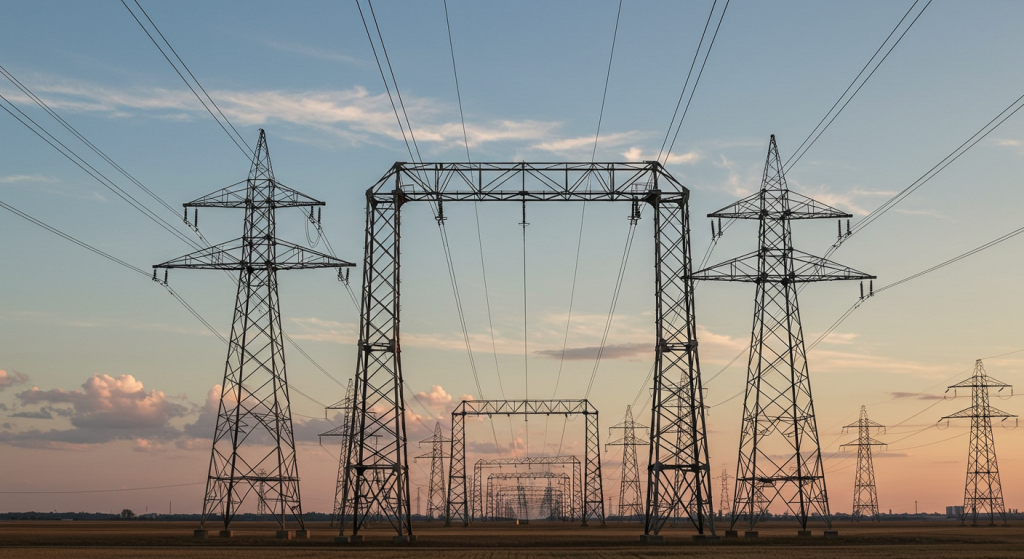Energy Transmission Towers: Everything You Need to Know
2025-04-27
What are Energy Transmission Towers?
Also called power transmission towers or electricity pylons, energy transmission towers play a vital role in facilitating electrical power delivery from generation centers to consumers. They are towering structures that carry overhead transmission lines, aiding in reliable and efficient electricity distribution over large distances.
10kV & 11kV Energy Transmission Towers: Essential Structures for Reliable Power Delivery
- The 10kV and 11kV energy transmission towers are critical structures in the overhead system of electric power transmission and distribution. These transmission towers enable the uninterrupted flow of energy from distribution stations and substations to users in urban, rural, and industrial areas.
- These towers represent dependable frameworks of the power grid infrastructure, designed to ‘host’ 10kV and 11kV voltage lines and interlink crucial nodes within the energy distribution network.
Product Features of Energy Transmission Towers
- Material Quality
Energy transmission towers require construction from materials that offer high strength, for example, Q235 or Q345 steel. This selection withstands aggressive mechanical and long-term demands. These materials are also tailored towards preventing corrosion and external wear, even in hostile environments.
- Structure Design
The design of the tower structure is synchronized with the Operating Voltage Levels, geographical area, and load conditions like wind and seismic forces. Single and double circuits can be configured with a range of transmission line structure designs.
- Adaptability to the Environment
The high-voltage towers can easily adapt to cross most types of terrain, including mountainous, hilly, and flat areas. Furthermore, the towers’ strength, structural reliability ensure that they are functional in the event of strong winds, seismic activities, or heavy snowfall.
- Safety and Strength
The strength and load-bearing capabilities make the towers trouble-free in terms of deformation or collapse. Safety features like lightning arresters and anti-corrosive paint enhance the performance and durability of the tower.
- Hassle-free setup
Prefabricated tower parts can be assembled on site, which reduces the amount of time and labor needed for construction. Thanks to the simple and strengthening design, the towers can be set up even in hard-to-access locations.
- Adjustable Height Customization
The height of the tower can be changed depending on the specifics of the terrain and system design. The proposed range is 10-50 meters, but in some designs it can reach 120 meters. This allows engineers to require conductor clearance without landscape interventions.

Uses of Energy Transmission Towers
- Power Networks in Metropolitan and Rural Areas
The 10 and 11 kV transmission line towers provide electricity to cities and enhance power availability to rural areas. Their connection of substations to the residential and commercial centers helps in providing seamless power services.
- Electricity for Industrial Activities
These towers find extensive application in the control of energy in industrial parks, manufacturing industries, and even in huge factories to manage their continuous operations, energy load,s and reliability.
- Extreme and High-Altitude Locations
Strong conditions enable them to be used in difficult places like the mountains and other high altitudes, where the surroundings are very demanding.
Specifications Of 10kV 11kV Single Circuit Transmission Line Towers
• Reliability:
XY 35 angular type and also hurricane proof has a service life of over 30 years while monitoring diverse installation conditions.
• Capability for High Voltages:
For 10kV & 11kV Suitability, and also fitting for 33kV - 35kV networks.
• Resistance to Corrosion:
Using hot-dip galvanizing will guarantee the best protection.
• Adjustable Heights:
Supplied in spans of 3 to 120m with versatile installation requirements.
• Compliance with Reliability Standards:
Accredited ISO 9001:2015 and compliant with other international standards on transmission towers.
Trustworthy Assurance of Quality
- We offer advanced telemetry towers within the industry. It is equipped with 10kV and 11kV transmission capability; its housing unit is made from raw materials that can withstand many conditions.
- At XY Tower, all of our products are manufactured under strict quality control and tested against national and global energy transmission standards. We select the best raw materials, ensuring proper assembly and installation with reliable, safe, and performing equipment designed for decades of operational excellence.
- Renewable energy technologies, along with other innovations today, enable the development of smart grids. These programmable frameworks not only automate data gathering in power systems but also enable remote operation infrastructure and the integration of renewable sources.
- Flexibility, strength, and efficiency are hallmarks of XY towers, providing requisite support to any expansion of existing power transmission infrastructure.
Design Considerations and Technical Aspects
- Another goal is to design contemporary transmission towers that draw on advanced engineering principles and modern materials while enhancing features to streamline fabrication and installation processes.
- Environmental, technological, and economic limits provide a framework within which tasks can be solved. Each problem should incorporate a certain level of optimal resource utilization.
- Energy towers' construction and innovation bring new features and refinements to existing engineering solutions using multidisciplinary approaches, giving infinite possibilities for the effective attainment of structural and aesthetic features.
- A sophisticated dynamic structural model is developed and based on Varangian principles, where extensive structural systems are formed using four types of motion: displacement, rotation, bending, and extension.
New Ideas and Futuristic Aims
Focusing on technologies to advance efficiency, sustainability, and resilience in the transmission tower industry:
• Smart Towers: Incorporating up-to-the-minute devices like Picture archiving and communication systems permits a tower to evaluate its structure at any given moment, aimed at ameliorating action and lessening downtime. X.Y. Tower
• Integration of Other Sources of Energy: Towers of Transmission towers are being changed to deal with the dynamics and might irregularities due to the rise in global use of renewable energy sources like wind and solar. As a result, the design of these towers is made so they can accept diverse sources of energy.
• Advanced Coatings and Materials: The application of protective coatings and materials increases the life expectancy of towers, especially in severe environmental conditions. This modification lowers the upkeep cost and increases the dependability of the power grid. tower-ist.com
Powering Progress: Applications Across Industries
Energy transmission towers have constituted everything from fundamental to advanced applications across various sectors:
• Electric Utilities: These are the main Steam driving the Electric Utility Towers Owners and Operators of electric tower amenities, forming the center core of their power delivery networks
• Power Generation: Ignition marks the beginning of the towers that connect power plants of every energy source to the main Grid, which is the heart of the distribution of generated electricity.
• Subsystems: Stepping up of the low voltage (or down) to the bottom for edition grades
• Transmission Networks: This constitutes the peak mark of every utilization tower, the place where the bulk amount of power has to be generated or transferred, and can be moved freely across geographic borders
• Smart Grid: Automation depends on the relics of the century, shoulder built up with widespread, sustained mountain towers
• Integrated with Renewable Energy: With supplementary new construction of power out of renewables, along with the completion of transmission towers, is needed.
• Long-Distance Power Transmission: To move electricity over long distances, high-voltage lines require power transmission towers to aid in energy transport.
Maintenance and Inspection
Regular upkeep and checks are crucial for the structural safety and longevity of the transmission towers:
• Routine Inspections: Scheduled assessments mitigate functional breakdowns through the identification of issues such as corrosion, weak structures, and other mechanical issues.
• Technological Aids: Drone and robotic technology, as well as advanced imaging, are becoming more prevalent in the inspection of towers, especially those that are hard to reach.
Conclusion
The evolution of electronics infrastructure has led to the need for energy transmission towers, which serve as a backbone while acting as barriers to modern distribution. These towers undergo continuous design innovation about materials, technology, and construction, which improves their efficiency, environmental friendliness, and resiliency, bringing us towards the advancement of dependable, sustainable power for the future. You can uncover further details regarding transmission tower services and innovations on the official website, XY Tower.

Hey, I’m Chunjian Shu
"X.Y. Tower: Reliable, innovative solutions for high-quality towers and electrical equipment with professional service.
